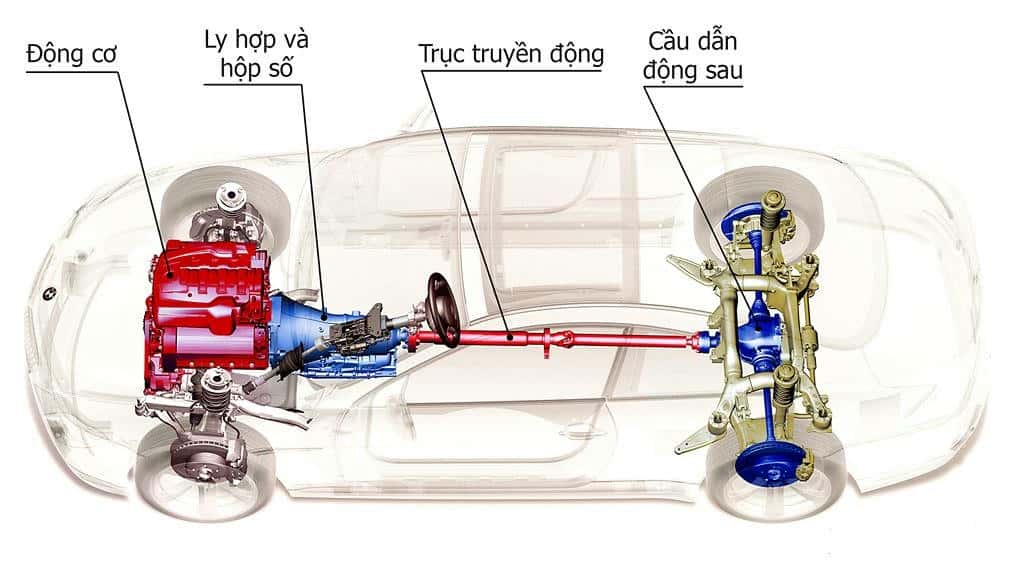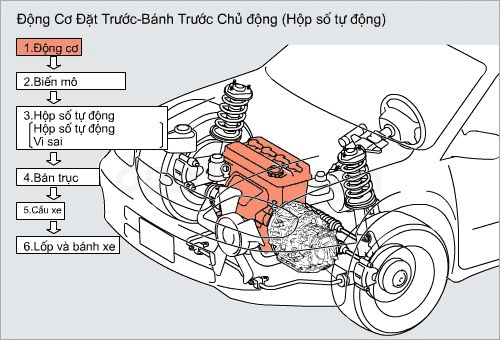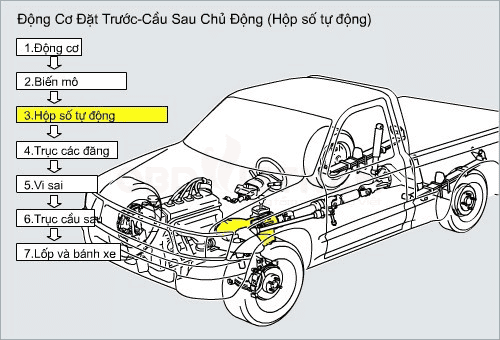What is the Power Transmission System in Automotives?
The power transmission system in automotives is a functional mechanism that automatically transmits torque to the vehicle's drive wheels, generating the thrust needed for movement. Key functions of the power transmission system include:
- Transmitting and transforming torque from the engine to the drive wheels.
- Temporarily interrupting the power flow for short or extended periods.
- Allowing the vehicle to move in reverse by changing the direction of movement.
- Adjusting the rotational speed and torque magnitude to match driving conditions, ensuring smooth operation.
Components of the Power Transmission System
The system consists of four main components: the clutch, gearbox, driveshaft, and differential.
 Source: Internet
Source: Internet
Clutch
Located between the engine and gearbox, the clutch serves to temporarily disconnect the power flow from the engine to the wheels during vehicle startup or gear shifting.
Gearbox
Positioned directly after the clutch, the gearbox converts engine power and adjusts the rotational speed and torque to meet driving requirements.
Common types of gearboxes:
- Automatic Transmission (AT)
- Manual Transmission (MT)
- Continuously Variable Transmission (CVT)
Manual transmissions require manual gear shifting via a gear lever and clutch pedal. In contrast, automatic transmissions use a "torque converter" instead of a clutch, enabling automatic gear changes.
Driveshaft (for rear-wheel or 4-wheel drive vehicles)
The driveshaft transfers transformed torque from the gearbox to the rear differential, overcoming challenges related to non-aligned and distant components within the vehicle.
Differential and Drive Axle
After the driveshaft, the differential receives power from the engine and distributes it to the wheels. The differential also adjusts power during turns for smooth operation. Additionally, the drive axle supports vehicle components such as suspension and chassis.
Tasks of the Power Transmission System
The system performs the following key functions:
- Transmitting and adapting torque and rotational speed from the engine to the drive wheels to match driving conditions.
- Temporarily interrupting the power flow when necessary.
- Enabling reverse motion by changing the direction of rotation.
- Regulating power distribution to the wheels for varying driving scenarios.
- Ensuring smooth movement and off-road capabilities during operation.
Types of Power Transmission Systems
The powertrain systems in modern passenger vehicles commonly include the following configurations: FF (front-engine, front-wheel drive), FR (front-engine, rear-wheel drive), 4WD (part-time four-wheel drive), and AWD (full-time all-wheel drive). Hybrid vehicles are also beginning to be developed.
FF Layout (Front-Engine, Front-Wheel Drive)
 Source: Internet
Source: Internet
FF vehicles (front-engine, front-wheel drive) have the engine and transmission arranged transversely relative to the vehicle's longitudinal axis. The torque is delivered directly to the front wheels.
With this drivetrain layout, vehicle weight is reduced by the absence of a driveshaft. The drivetrain system becomes simpler, which lowers maintenance and repair costs. A shorter power transmission path results in higher torque efficiency and reduced power loss. Additionally, the two front-driven wheels enhance stability during driving.
FR Layout (Front-Engine, Rear-Wheel Drive)
 Source: Internet
Source: Internet
Rear-wheel drive (RWD) vehicles use a drivetrain system that powers the two rear wheels, meaning the engine directly transmits force to the rear axle. The power is transferred from the engine through the transmission, driveshaft, rear differential, and then to the rear wheels. This drivetrain configuration is often used in vehicle models that focus on performance, require strong propulsion, or have high load-carrying demands.
The advantages of rear-wheel drive include the rear placement of the drivetrain, which provides a more spacious engine bay, allowing for the installation of larger engines and reducing the turning radius and steering effort, thereby delivering a sportier driving feel.
Additionally, the vehicle's weight is more evenly distributed, ensuring both the front and rear wheels maintain good traction, which helps the vehicle operate more stably. Particularly at high speeds, RWD vehicles can maximize thrust, enabling faster acceleration and higher load-carrying capacity. Another notable advantage is that RWD vehicles are simpler to repair and maintain compared to front-wheel drive vehicles.